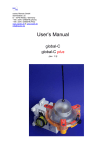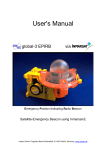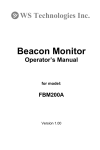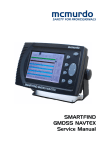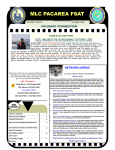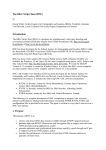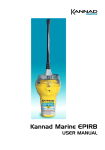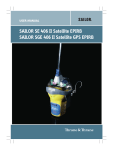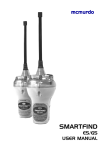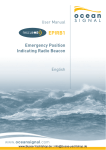Download User's Manual - Hippopotamus
Transcript
navtec GmbH Flughafen Berlin-Schönefeld D - 12521 Berlin / Germany + 49 / 30 / 6091-8222 (phone) + 49 / 30 / 6091-8222 (FAX) www.navtec.de & www.epirb.de [email protected] User’s Manual global-C global-C plus (rev. 1.1) global-C / global-C plus user‘s manual navtec GmbH Contents 1 Introduction.......................................................................................................................3 1.1 Overview........................................................................................................................3 2 Overview of individual parts ...........................................................................................4 3 Activation...........................................................................................................................5 3.1 The Main Switch...........................................................................................................5 3.2 Testing the EPIRB .......................................................................................................5 3.3 Manual Activation.........................................................................................................6 3.4 Manual Deactivation....................................................................................................7 3.5 Automatic Activation in the cradle .............................................................................8 3.6 Use of the Cradle .........................................................................................................9 3.7 Buoyant lanyard .........................................................................................................10 4 Installation.......................................................................................................................10 5 Use of the beacon with a Remote Control Unit (RCU).............................................11 5.1 Display Contrast .........................................................................................................11 6 EPIRB Registration........................................................................................................12 7 False Alerts .....................................................................................................................13 8 HW-Design......................................................................................................................14 9 FW-Design......................................................................................................................14 10 PC-Software....................................................................................................................14 11 Strobe Light.....................................................................................................................15 12 Type approvals ...............................................................................................................16 12.1 Declaration of Conformity to Type / Konformitätserklärung ............................17 12.2 BSH Wheelmark Certificate..................................................................................18 13 Labels ..............................................................................................................................20 14 Appendix 1 : Dimensions ..............................................................................................21 15 Appendix 2 : Technical Data ........................................................................................22 16 Appendix 3 : Maintenance, Care and Service...........................................................23 17 Appendix 4 : Service......................................................................................................23 18 Appendix 5 : Errors and Problems ..............................................................................24 19 Appendix 6 : Associated Rescue Co-ordination Centres ........................................25 global-C_users_manual.doc Page 2 of 25 Last printed 10.11.06 global-C / global-C plus user‘s manual navtec GmbH 1 Introduction This document introduces the navtec global-C and global-C plus. Both are 406 MHz beacons based on navtec’s successful global-3 design. The document is intended to explain the usage of the beacon. 1.1 Overview The global-C design covers two versions : 1. global-C, a COSPAS-SARSAT beacon on 406,028 MHz without built-in GPS comes in a yellow body. and 2. global-C plus, same design with built-in GPS comes in an orange body. Both beacons are housed in the proven global-3 polycarbonate body distinguished by the colour. Activation, deactivation and handling have been adapted from this design. Function, design and handling have been wheelmark approved by BSH / Hamburg/Germany. The design of the navtec global-C EPIRB for COSPAS-SARSAT is based on the global-3. It comes in a polycarbonate body with vertical polarised antenna for 406 MHz and 121,5 MHz. Body colours are • Yellow (RAL 1026) beacons without GPS (global-C) • Orange (RAL 2007) for beacons with GPS (global-C plus) The cradle is available in • Yellow (RAL 1018) • Grey (RAL 7000, mil. colour) • Blue (RAL 5013) • White (RAL 9010) The cradle incorporates the HRU 1 The design is a class-2 type in temperature (-20 °C). It is a full SOLAS / GMDSS compliant since the navtec parts fulfil all necessary requirements for pressure, drop test, release mechanism, etc. The navtec global-C contains a 121,5 MHz homing beacon. It does not contain a SART. 1 Hydrostatic Release Unit, both type approved units McMurdo/Pains Wessex and HAMMAR can be used. global-C_users_manual.doc Page 3 of 25 Last printed 10.11.06 global-C / global-C plus user‘s manual navtec GmbH 2 Overview of individual parts The following photo lists the individual parts of the navtec global-C EPIRB. 9 8 10 11 16 14 12 1 15 6 13 7 5 2 6 4 3 No. Description Page 1 Safety Device p. 5 2 Main switch (Activation, Deactivation and Test) p. 5 3 EPIRB body with instructions and printed HEX-ID 4 Cradle p. 8 5 Hydrostatic Release Unit p. 8 6 Mounting bracket securing holes 7 Hydrostatic Release bolt p. 8 8 Plastic spring to enable release of cradle from mounting bracket p. 9 9 Cradle p. 9 p. 20 p. 10 10 Printed battery exchange date / Service interval p. 23 11 Printed MMSI (for Identification purpose only) p. 12 12 Retro-reflective Tape complying to SOLAS regulations 13 Vessel’s name p. 12 14 Antenna dome with integrated strobe light p. 10 15 Buoyant lanyard, (on the right side of the EPIRB) p. 10 16 Antenna for 121,5 and 406 MHz global-C_users_manual.doc Page 4 of 25 Last printed 10.11.06 global-C / global-C plus user‘s manual navtec GmbH 3 Activation 3.1 The Main Switch The navtec global-C EPIRB is fitted with a main switch with three positions. The fo llowing picture shows the main switch. The main switch of the navtec global-C EPIRB has three positions : TEST ßà OFF ßà SOS Operation of the switch in the Alarm (SOS) position is prevented by a security device. 3.2 Testing the EPIRB The navtec global-C EPIRB can be tested by moving the main switch to the left and holding it there for one second, releasing the switch and wait until one beep tone is heard. When the main switch is activated in the TEST position resistance in the form of a little step down must be overcome. This is to prevent the test from being activated inadve rtently. To test the navtec global-C EPIRB, the switch will be pushed to the left and released after a second. Testposition TEST After a few seconds, one beep tone will be heard. This means the test is satisfactory. The switch should return to its normal central position by itself. More than one beep tone indicates an error. See page 24 for details. During the test, a test message is generated and transmitted on 406,028 MHz. Besides this, all internal components are tested. • 406 MHz TX by transmitted power • 121 MHz TX by transmitted power • LED by current • Battery by voltage drop and counted events global-C_users_manual.doc Page 5 of 25 Last printed 10.11.06 global-C / global-C plus user‘s manual • Beeper by audible inspection • Internal RAM and FLASH by Checksum, write- and read test. • Program by checksum navtec GmbH If no beep tone is heard, there is a malfunction of the EPIRB. In this case the navtec EPIRB global-C MUST be sent to a qualified service centre immediately. If there are any other malfunctions the EPIRB indicates the error with different beep tones. The navtec global-C EPIRB counts and logs all tests in an internal non-volatile memory logbook. The amount of tests are used to calculate the total energy consumption. Approximately 500 tests are possible within the battery life to ensure enough energy remaining for reliable 48 hour service. 3.3 Manual Activation Before manually activating the beacon, the security device will have to be removed by pulling it upwards. When the device is removed, the switch can be moved to the right to activate the navtec global-C EPIRB. remove the ring SOS, push switch to the right In an emergency the security device must be removed by pulling it upwards. Then the switch can be moved to the right in the SOS/Alarm position to activate the beacon and place the beacon into water immediately. 2 In the path to the right, a little step (down) must be overcome. This is to prevent the alarm from being inadvertently activated. The switch should lock in the SOS/Alarm position. After activating the beacon, there is an approximately one minute waiting period until the first transmitted burst is transmitted. During this waiting period, the navtec global-C EPIRB generates an audible alarm. Only within this period, the beacon can be deactivated without transmitting a distress alert via the satellite. 2 COSPAS-SARSAT beacons need and use the water surface as a ground plane for a good signal radiation. global-C_users_manual.doc Page 6 of 25 Last printed 10.11.06 global-C / global-C plus user‘s manual navtec GmbH After this period the audible alarm ceases and the beacon starts the alert transmission. If the beacon is deactivated after audible alarm has ceased, a distress alert will have already been sent (via satellite) and the nearest RCC has to be contacted. Prior to activating the switch, the security device has to be removed. Since this device has barbs that break when the ring will be removed, it is quite easy to indicate that the beacon at least has been activated 3 once. In addition, the activation will be logged in an internal non-volatile logbook and can be used to indicate a battery problem in self-test mode. After activation of the beacon it shall be placed into water. 3.4 Manual Deactivation Deactivating : The navtec global-C EPIRB may be deactivated by moving the switch to the left (test-position) and holding it there for 10 seconds. When the main switch is activated in the TEST position a resistance in the form of a little step down must be overcome. In addition to the 10-sec. hold time this is to prevent the unit from being inadvertently deactivated. Deactivation hold 10 sec. Within a one-minute period, the beacon can be deactivated without transmitting via satellite. After the one-minute period and when the audible alarm has ceased an actual distress alert has been sent. If the beacon is deactivated after this period, the nearest RCC MUST be informed immediately. In any event a one minute waiting period will occur between activation of the beacon and transmission of the distress alert. During this waiting period, the navtec global-C EPIRB generates an audible alarm. This audible alarm is a special feature of navtec beacons. 3 See 3.3.9, Indication of previous activation of 61097-2 global-C_users_manual.doc Page 7 of 25 Last printed 10.11.06 global-C / global-C plus user‘s manual 3.5 navtec GmbH Automatic Activation in the cradle The navtec global-C EPIRB forms an automatic unit when used in conjunction with the cradle to send distress alerts without human intervention if the vessel sinks. Bolt The beacon is secured in the cradle using a hydrostatic release and a plastic bolt. Hydrostatic Release Automatic When the vessel sinks, the hydrostatic release cuts the bolt and the beacon floats to the surface. The combination of being released from the cradle and the presence of water causes the beacon to start automatic distress alerts transmissions. A distress alert is transmitted when the ship sinks and the navtec global-C EPIRB was mounted in its cradle. Manual activation is therefore not necessary. global-C_users_manual.doc Page 8 of 25 Last printed 10.11.06 global-C / global-C plus user‘s manual navtec GmbH 3.6 Use of the Cradle The methods of manual activation and testing of the beacon are identical both with and without the cradle. The following benefits apply when using the cradle. The navtec global-C EPIRB can easily be removed from the cradle mounting to store it, or to protect it from being stolen. Take out : The EPIRB can be taken out of the cradle The beacon can be removed by pulling it mounting by first pushing the plastic upwards. spring towards the beacon. If the navtec global-C EPIRB is removed from the cradle, no distress call will be sent ! Only if the navtec global-C EPIRB is immersed under water in the next few seconds will self-activate the beacon. This functionality makes the inadvertent transmission of a distress alert much more difficult 4. After activating the beacon, a one minute waiting period starts. This also applies to the automatic activation. During this waiting period, the navtec global-C EPIRB generates an audible alarm. Only within this period, the beacon can be deactivated without transmitting a distress alert via the satellite. This audible alarm is a special navtec beacon’s feature to prevent false alerts. 4 2.3, table-1 in of 61097-2 global-C_users_manual.doc Page 9 of 25 Last printed 10.11.06 global-C / global-C plus user‘s manual navtec GmbH 3.7 Buoyant lanyard There is a buoyant lanyard of approximately 6 meters attached on the right side of the EPIRB. A tie wrap holds the lanyard in position. It can easily be manually opened. The lanyard shall be tied to the life-raft to prevent the beacon from floating away from the person in distress. The lanyard may be yellow or red on delivery of the beacon. 4 Installation The correct installation of the navtec global-C EPIRB cradle should be carried out by your dealer or distributor. The following rules MUST be adhered to : • The navtec global-C EPIRB with cradle and hydrostatic release unit must not be mounted inside a vessel. If the vessel sinks the beacon will not be able to float free to the water surface. The navtec global-C EPIRB MUST be mounted outside. • The navtec global-C EPIRB should not be mounted outside the rail or the vessels superstructure facing the water. This is to reduce the likelihood of damage due to the beacon coming into contact with other vessels the dockside or waves. • The antenna dome should have free "visibility" from horizon to zenith. The transmitting and receiving antennas are located inside the antenna dome. With reduced or blocked "visibility" the it will be difficult, if not impossible to communicate with the GPS and COSPAS-SARSAT satellites. • The navtec global-C EPIRB must not be mounted at the same height as the vessels radar. • The navtec global-C EPIRB must not be mounted within 1 m of a compass or an auto pilot with a built-in compass. • The navtec global-C EPIRB must not be mounted within 1 m of any radio ante nnas. The mounting distance to radio antennas with an output power of more than 50 W should be at least 5 m in a horizontal direction. • The screws for mounting the cradle must not be over tightened. Over tightening the screws will result in distorting the polycarbonate cradle. Installing the cradle on a wooden or aluminium mounting is strongly recommended. global-C_users_manual.doc Page 10 of 25 Last printed 10.11.06 global-C / global-C plus user‘s manual navtec GmbH 5 Use of the beacon with a Remote Control Unit (RCU) The navtec global-C plus EPIRB (only) can be fitted with an optional remote control unit 5 (RCU). In this case, a cradle with electronic interface shall be used. When an EPIRB and RCU are ordered together, an electronic interface equipped cradle will be shipped automatically. The cradle and the RCU are connected using a 6-wire shielded cable. The operation of the navtec global-C EPIRB is extended by the installation of the RCU. Both manual and automatic activation methods remain the same. To activate the beacon press both SOS-buttons simultaneously and hold for 5 seconds. Immediately after activating the beacon it must be deployed into water. 6 The navtec global-C EPIRB RCU e nables: • activating the beacon and transmit a distress alert, • enter the nature of distress in the national use bits 7, • test the EPIRB, • display the GPS position on the LCD display and • output the GPS position and time at the RCU’s NMEA output for inspection and possible use with other equipment as required. 5.1 Display Contrast The display contrast can be altered by pressing either test buttons Test-Ù and Test-Ú : Test-Ù Increase contrast Test-Ú Reduce contrast 5 The usage of a RCU is based on para. 4.5.2 in T.001 and 3.13 c in IEC 61097-2. 6 COSPAS-SARSAT beacons need and use the water surface as a ground plane for good signal radiation. 7 Today (2005) Germany only global-C_users_manual.doc Page 11 of 25 Last printed 10.11.06 global-C / global-C plus user‘s manual navtec GmbH 6 EPIRB Registration As all COSPAS/SARSAT beacons the navtec global-C/global-C plus EPIRB must be registered with the local authority. This is very important to get hold of the owners particulars in case of an emergency. In addition the navtec global-C/global-C plus EPIRB must be programmed with ship’s particulars. Depending on the country of registry this may be Ø MMSI, Ø Callsign or Ø C-S TA + serial number Normally, this programming and registration will be carried out by your dealer or distributor. All users are encouraged to register their beacon in the COSPAS-SARSAT international registration database (IBRD) that will allow beacon owners who don't have access to national registration facilities to register their beacons free of charge via the Internet (www.406registration.com). Once registered, the beacon registration details will be available to SAR services throughout the world on a 24 hour basis. global-C_users_manual.doc Page 12 of 25 Last printed 10.11.06 global-C / global-C plus user‘s manual navtec GmbH 7 False Alerts When a navtec global-C/global-C plus EPIRB is activated, it generates an audible warning signal for one minute. This indicates a pending distress alert to the user. The audible warning signal provides the user with the possibility to de-activate the beacon and prevent transmission of a distress alert. After this one-minute period the navtec global-C/global-C plus EPIRB starts to transmit the distress alert. The distress signal may be forwarded from the receiving MCC 8 network to the appropriate RCC 9 within short time period. F One should keep in mind that every activation of an EPIRB distress alert is treated as a real alert and causes extensive search and rescue activities! These search and rescue activities are extremely expensive and only cease when the EPIRB has been found, or it is proven beyond doubt that the distress alert was false! Unnecessary deployment of SAR assets may also delay or prevent rescues due to a real distress. If the navtec global-C/global-C plus EPIRB is activated by accident, the nearest RCC 10 should be contacted immediately to cancel the alert. should also be noted that the EPIRB may have already transmitted the F Itvessels position and identification, even when the distress call has been stopped part of the way through ... In other words : The originator of a distress call will not stay unrecognised. 8 Mission Control Centre 9 Rescue Co-ordination Centre 10 see page 25 for (M)RCC telephone numbers global-C_users_manual.doc Page 13 of 25 Last printed 10.11.06 global-C / global-C plus user‘s manual navtec GmbH 8 HW-Design All components are accommodated on one circular PCB which perfectly fits into the polycarbonate body. Reed switched are used to activate the beacon. In addition to the mandatory “TEST” and “SOS” contacts, a third reed contact is installed in the OFF-position to prevent from inadvertent activation due to strong magnetic fields (!). A lesson learned from other manufacturers in the past. 9 FW-Design A 16-Bit micro controller with embedded operating system controls the complete unit. This controller accommodates a non-volatile FLASH ROM to log events like activation, deactivation, etc. 10 PC-Software A PC program is used to write user data into the beacon. The following picture shows a screen shot. This program is intended for distributor or dealer use to program the beacon. The PC-Software is updated by navtec via Internet from time to time to include new features, new MIDs and new or modified protocols. Configuration software, main screen. global-C_users_manual.doc Page 14 of 25 Last printed 10.11.06 global-C / global-C plus user‘s manual navtec GmbH If the beacon is inserted in the cradle and powered with ships energy the PC-softwae also allows for GPS receiver test and display all visible satellites in a chart like this. Configuration software, GPS tabsheet This PC-program communicates via an IrDA interface with the beacon. Only ISO layer one and two are used to prevent from illegal manipulation of the internal data. 11 Strobe Light The navtec global-C EPIRB incorporates a white LED to act as the mandatory strobe light. This new 10 cd. LED light over-fulfils the requirements of T.001 and IEC61097-2 (0,75 cd.) The labels on global-C plus are dark blue text on clear carrier providing good visibility if attached t o the yellow or orange body. global-C_users_manual.doc Page 15 of 25 Last printed 10.11.06 global-C / global-C plus user‘s manual navtec GmbH 12 Type approvals COSPAS-SARSAT type approval TAC 160 BSH Wheelmark approval http://www.cospas-sarsat.org/Beacons/BeaconReports/160-1.pdf www.navtec.de/ download/global-c_plus_wheelmark_bsh.pdf The following subchapters contain the Declaration of Conformity to Type and the BSH EC Type Examination Certificate (Wheelmark). global-C_users_manual.doc Page 16 of 25 Last printed 10.11.06 global-C / global-C plus user‘s manual navtec GmbH 12.1 Declaration of Conformity to Type / Konformitätserklärung • Hiermit wird bescheinigt, daß das ausgelieferte Produkt navtec EPIRB global-C plus dem Prüfmuster und der Prüfbescheinigung entspricht. • We hereby declare that the product navtec EPIRB global-C plus is in conformity with the type as described in the type approval certificate. Declaration of Conformity to Type for navtec global-C plus EPIRB BSH type approval number : 0735-05 and 0735-06 COSPAS-SARSAT type approval number : TAC-160 We hereby declare that the product • navtec EPIRB global-C plus (with and without remote control unit, RCU) is in conformity with the type as described in the EC/German type approval certificate • BSH/4612/5060211/06 (with and without RCU) and satisfies all the technical regulations applicable to the product within the Telecommunication Type Approval Ordinance : • IEC 61097-2, IEC 60945, ETS 300 066-2, MSC Circ. 862 • COSPAS-SARSAT T-001 class 2 Manufacturer and point of contact : navtec GmbH Flughafen Berlin-Schönefeld D - 12521 Berlin, Germany Phone : +49 / 30 / 6091-8222, FAX : +49 / 30 / 6091-8223, mail : [email protected] --------------------------------------------------------(navtec GmbH, Dr. Anselm Fabig) global-C_users_manual.doc Page 17 of 25 Last printed 10.11.06 global-C / global-C plus user‘s manual navtec GmbH 12.2 BSH Wheelmark Certificate global-C_users_manual.doc Page 18 of 25 Last printed 10.11.06 global-C / global-C plus user‘s manual global-C_users_manual.doc Page 19 of 25 navtec GmbH Last printed 10.11.06 global-C / global-C plus user‘s manual navtec GmbH 13 Labels All labels attached to the body and the cradle are printed below. The labels on global-C are dark blue text on clear carrier providing good visibility if attached to the yellow or orange body. The serial number and hex-ID is printed perpendicular in the field at the right side of the label below the text “warning : This EPIRB must be registered with the local authorities” global-C_users_manual.doc Page 20 of 25 Last printed 10.11.06 global-C / global-C plus user‘s manual navtec GmbH On top of the beacon a label (white on red) indicates the type of the beacon (global-C or global-C plus) and provides space for next service (battery exchange) i ndication. 14 Appendix 1 : Dimensions 230 200 130 80 300 210 230 210 140 300 Top view, dimensions in mm global-C_users_manual.doc Side view, dimensions in mm Page 21 of 25 Last printed 10.11.06 global-C / global-C plus user‘s manual navtec GmbH 15 Appendix 2 : Technical Data Type COSPAS-SARSAT, 406 MHz 220 mm (height, w/o antenna) x 210 mm (diameter) Housing dimensions, see drawing (8,66 " by 8,26 ") see figure below Weight Approx. 1100 g (2,42 lbs) without cradle Material Polycarbonate Colour (global-C) yellow, RAL 1026 Colour (global-C plus) orange, RAL 2007 (or red, RAL3026) Maintenance interval / Battery change 4 years (IMO) Service interval of hydrostatic release unit 2 years (IMO) 1. Manual, Activation methods 2. Automatic when sinking, 3. Remote controlled from ships bridge Ejection level (depth) 1,5 to 4m Primary frequency 406,028 MHz (UHF) Type of modulation 1,1 rad PSK Transmission power, EPIRB 37 dBm / 5 W Frequency error better +/- 1ppm Secondary frequency, homing beacon (ELT) 121,5 MHz (VHF) Modulation scheme AM / A9 / NF-Sweep Transmission power, homing beacon 17 dBm = 50 mW Frequency error, homing beacon < 50 ppm Integrated Flash white, ca. 10 cd ca. 29 flashes/min. Velocity 5g, up to 50 Hz, all Axis o o Temperature range Class-2 : -20° to +55°C (-4 F to 131 F) Integrated self test with check of all functions, includInternal self test ing GPS. Logging of results in FLASH-ROM Transmission period after activation min. 48h Usable geographic regions World wide Position finding, global-C plus only acquisition time GPS-RX, 12-channel, <100 sec. Period of time between triggering and alarming >1 min Optional RCU Output NMEA Data : Position, Speed, Heading Electronic and mechanical design according to RTCM, C-S T.001,IEC 61097-2, IEC 60945-4 SPECIFICATIONS ARE SUBJECT TO ALTERATION WITHOUT PRIOR NOTICE global-C_users_manual.doc Page 22 of 25 Last printed 10.11.06 global-C / global-C plus user‘s manual navtec GmbH 16 Appendix 3 : Maintenance, Care and Service The navtec global-C/global-C plus EPIRB is easy to maintain between the four years service intervals. There are no serviceable parts inside. • The beacon and the cradle should be cleaned with clean water and a soft cloth using a mild detergent such as used for cleaning dishes. Brushes, abrasive cleaning powder or any solvent must not be used. No detergent must remain on the beacon or it’s cradle. The beacon, cradle and mounting should be rinsed with lots of clean water. • If cleaning agents or other chemicals remain on the beacon, cradle or mounting, they lead in conjunction with (UV) sunlight and time to cracks and deterioration of the polycarbonate material (!!!) • The navtec global-C/global-C plus EPIRB or the cradle and mounting must not be painted. • The beacon should not be tested too often, because this degrades the battery life. One test every month or at the beginning of every voyage is enough. The hydrostatic release unit must be changed every two years. • The navtec global-C/global-C plus EPIRB should be serviced every four years at an approved service station. The lithium battery will be changed during this service. 17 Appendix 4 : Service The navtec global-C / global-C plus EPIRB should be serviced every four years at a registered, qualified service centre. This service includes the lithium battery being replaced. The service centre will also carry out comprehensive testing of navtec global-C / global-C plus EPIRB. During this 4-annual service the beacon seals and springs will be replaced. Apart from the beacons service interval the hydrostatic release unit MUST be changed every two years. This can be done by every HAMMAR approved service centre. Both service intervals are required by the IMO and navtec. They MUST be carried out. Regular service maintains and enhances safety by ensuring that navtec global-C / global-C plus EPIRB remains in peak condition should it ever be required in a real distress situation. The navtec global-C / global-C plus EPIRB should also be serviced after every (i ntended and inadvertent) alarm transmission at a registered, qualified service centre. This service includes the lithium battery and the security device being replaced. The service centre will also carry out comprehensive testing of the navtec global-C / global-C plus EPIRB. If in doubt, inquire at navtec or send beacon to navtec GmbH Airport Berlin-Schoenefeld, Building Y-005 D - 15831 Diepensee, Germany +49 / 30 / 6091-8222 (phone), [email protected] global-C_users_manual.doc Page 23 of 25 Last printed 10.11.06 global-C / global-C plus user‘s manual navtec GmbH 18 Appendix 5 : Errors and Problems This is a list of error codes. An error code is indicated by the generation of different beep tones after any test of the beacon. Details of how to perform a self test of the navtec global-C/global-C plus EPIRB is explained on page 5 of this manual. Number of beep tones after self test Morse Code No tone 1 • 2 •• 3 ••• 3 or more Meaning of beep code What to do ? There is no power left in the battery Please arrange to have the beacon serviced immediately at the nearest approved service centre. Test passed satisfactorily Everything is ok, the beacon is ready for action. Within extended GPS-Test this move to unobstructed Error may occur : No GPS Po- position, try again sition after 3 minutes The battery is partly drained. This problem occurs, if too many tests have been carried out. Please arrange to have the beacon serviced immediately at the nearest approved service centre. The beacon may not be able to transmit for the required 48 hours. • • • • (h) A severe fault has occurred. • • • • • (5) This fault cannot be repaired • (a) on board the vessel. • (n) • • (u) • • (d) • (w) • (k) • (g) Please arrange to have the beacon serviced immediately at the nearest approved service centre. If the beacon is used while inserted into the cradle and with a RCU connected, a quiet "crackling" sound may be heard. This is not a fault. You can hear the operation of the built-in switching power supply. When the beacon is used in this way a green LED will be visible in the navtec global-C / global-C plus EPIRB. global-C_users_manual.doc Page 24 of 25 Last printed 10.11.06 global-C / global-C plus user‘s manual navtec GmbH If the navtec global-C / global-C plus EPIRB is removed from the cradle, the white LEDs will flash for an instant. This also gives you a visual check to see if the beacons LEDs are all working. This is caused, because the internal computer checks if, as the beacon has been released from it’s cradle, the beacon is under water. Please note, that you must not remove the unit every day or more than is necessary, because this leads to degradation of battery life. The amount of self tests and every removal from the cradle are logged and recorded in an internal logbook. The result of these records are used to calculate the remaining battery life. 19 Appendix 6 : Associated Rescue Co-ordination Centres The following table shows telephone and fax numbers of some RCCs. They receive COSPAS-SARSAT distress call after short time period. If an EPIRB is activated inadvertently, one of the following RCCs should be notified immediately. Please note that these numbers and addresses can change with time and neither COSPAS-SARSAT or navtec GmbH can be held responsible for any loss or damages resulting from these numbers being incorrect. Country / Land RCC Australia RCC Australia Germany MRCC Bremen England MRCC Falmouth USA RCC Alameda global-C_users_manual.doc Adresse / Address Telephone / FAX Australian Maritime Safety Authority, Level 3, 25 Constitution Ave GPO Box 2181 Canberra, ACT 2601 Australia German Sea Rescue Service, DGzRS, MRCC Bremen, Werderstr. 2, D-28199 Bremen, Germany HM Coast Guard, Pendennis Point, Castle Drive, Falmouth, Cornwall TR11 4WZ, UK Tel: +61 2 6230 6811 Fax: +61 2 6230 6868 Tlx: +71 62349 MRCCAUS E-Mail: [email protected] Pacarea/District Eleven Command Center, Coast Guard Island, Alameda, CA 94501-5100, USA Page 25 of 25 Tel: +49 421 53707 460 Fax: +49 421 53707 490 Tlx : (41) 246466 MRCC D Inm-C: 492621021 Tel: +44 1326 317575 Fax: +44 1326 318342 Tlx: (51) 45560 FALMCG G Inm-A (E): 581/871 1441532 Inm-C (E/W): 581 423200158/584 423200159 Tel: +1 (510) 437 3701 Fax: +1 (510) 437 3017 Tlx: (230) 172343 CG ALDA Last printed 10.11.06

























